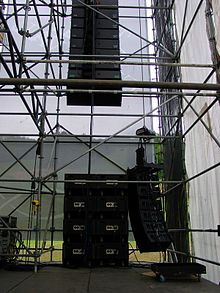Line array
Line arrays can be oriented in any direction, but their primary use in public address is in vertical arrays which provide a very narrow vertical output pattern useful for focusing sound at audiences without wasting output energy on ceilings or empty air above the audience.
A vertical line array displays a normally wide horizontal pattern useful for supplying sound to the majority of a concert audience.
A row of subwoofers along the front edge of a concert stage can behave as a horizontal line array unless the signal supplied to them is adjusted (delayed, polarized, equalized) to shape the pattern otherwise.
Therefore, each enclosure must be designed to rig together closely to form columns composed of high-, mid- and low-frequency speaker drivers.
The large format line array has become the standard for large concert venues and outdoor festivals, where such systems can be flown (rigged, suspended) from a structural beam, ground support tower[2] or off a tall A-frame truss tower.
[3] Since the enclosures rig together and hang from a single point, they are more convenient to assemble and cable than other methods of arraying loudspeakers.
[4] The line array effect of the narrowing of the beam with increasing frequency was first demonstrated by acoustical pioneer Harry Olson.
[7] A multi-band line array elements in a horizontally oriented enclosure was suggested by Joseph D'Appolito in 1983.
[9] This led to the discovery that a more level and smoother frequency response can come from fewer boxes in a line array.
For the high frequencies, some other method must be employed to attain directional characteristics that match those of the lows and mids.
Rather than using constructive and destructive interference, horns achieve directionality by reflecting sound into a specified coverage pattern.
If this is achieved, then the wave guide elements can be integrated into the line array and, with proper equalization and crossovers, the beam from the high frequencies and the constructive interference of the low frequencies can be made to align so that the resulting arrayed system provides consistent coverage.
This provides a long throw straight line component for people relatively far away, while the curve at the bottom acts as an in-fill for the area underneath the array that would otherwise be neglected Spiral arrays are the next development from J-arrays, and have a superior frequency response due to their similar polar pattern at shifting frequencies, while still retaining the long throw and in-fill benefits that J-arrays provide.
[14] Large-format line arrays are designed for arena and amphitheatre tours, large venues and outdoor festivals.
The design process starts by entering the dimensions of the room and the required sound pressure level.
Alternatively, some programs require the number of boxes entered and it will predict the resulting sound pressure levels in different parts of the room.
Once designed, the rigging points are hung from the structure, followed by chain motors (or blocks), flying frame and then the speakers.
Compared to flown speakers, they require less vertical dispersion to cover front to back and the resulting array will have little curvature.




